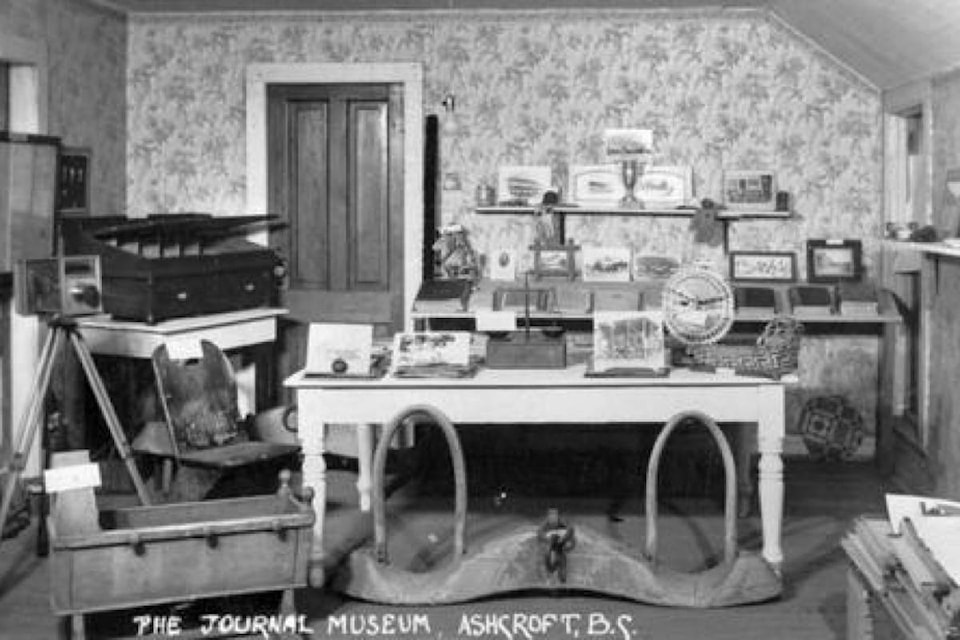Summer is almost here, and Golden Country will spend the summer looking at museums in our region. If you think that once you have seen a museum you never need to visit it again, because it never changes, then think again.
The Ashcroft Museum, at the corner of 4th and Brink Streets, is one of the more recognizable buildings in Ashcroft, partly because it is the only brick-faced building in the town (which is odd, since it was faced in wood when it was constructed in 1917; the brick was added in 1935). For many people it is probably the only Ashcroft Museum they have ever known; but it is, in fact, the fourth museum site in the town.
The first Ashcroft Museum was located above the office of The Journal, and was a labour of love for Journal editor R.D. Cumming, who had moved to the area in the 1880s and collected artifacts for many years. He became editor of the paper in 1912, and opened the museum in 1935; an early photograph of the collection shows many items that now have pride of place in the current museum.
In the early 1950s the collection was moved to the vacant Harvey Bailey warehouse on the east side of Railway Avenue, where it remained on display for several years. The Cumming family donated the collection to the village when the Canadian Pacific Railway, which owned the warehouse, decided to tear the building down, and the artifacts remained in storage for some time, with a very real fear that the items would all be consigned to the dump.
With this in mind, a donation drive was launched in order to fund the construction of a new museum building that would also serve as a new fire hall. Saturday night “donation dances” were held to raise funds, with “bricking bees” following on Sunday mornings. According to Lew Cumming, Jr., it is possible that some of those Sunday morning brickwork sessions might have led to brickwork that was “a wee bit crooked”; but the work got done, and in 1958—the year of R.D. Cumming’s death—the new combination museum and fire hall opened in Cumming’s name, adjacent to the 1919 fire hall (now located at the north end of Railway).
The collection—which had been much-expanded over the decades—remained in the museum/fire hall building until the late 1970s. In 1978–79 a Canada Works Project was initiated to catalogue the artifacts and update the displays, and the report noted that the building left much to be desired regarding preservation of the items and the space required to display them adequately.
In 1980 Claire Burns, Robert Graham, and Heather Hartridge put together a report entitled “A New Ashcroft Museum: A Proposal”. They examined the history of the Ashcroft Museum and noted that “The present building has many problems due to its size and construction. It is over-crowded in both exhibit and storage areas. The concrete block building is not well made and dust and dirt seep through many cracks in the walls. There are no temperature or humidity controls. There is no room for a gift shop, travelling exhibits, audio-visual shows, or other public projects. There is no work space for preparing and cleaning artifacts.”
The authors noted that “The major reason for a new museum building … is to give the museum more impact inside and out which will draw more of the tourist traffic into the town.” They looked at several buildings as potential museum sites, and decided that “the largest and most attractive of these buildings is the old Post Office.”
Since 1917 the Ashcroft post office—as well as the customs office, telegraph office, and telephone exchange—had been housed at the public building at the corner of 4th and Brink. One by one these offices had departed the building, and in 1978 the post office left, occupying new quarters at the corner of 4th and Railway (built on the site of the former Ashcroft Hotel, which had burned down in 1916, been rebuilt, and then had burned down again in 1974). This left only a Manpower Office on the upper floor of the building, with the lower floor and basement empty.
The authors of the 1980 report gave a brief history of the town, then discussed modifications that would need to be made to the public building in order to accommodate and protect the collection, such as closing off most of the windows to prevent sunlight damaging the artifacts. They also outlined the proposed displays, which would highlight such things as First Nations culture, the fur trade, the gold rush, agriculture, transportation, and family and town life in Ashcroft over the years.
The report concludes “Ashcroft played an important and fascinating role in B.C.’s history. The remains of Ashcroft’s heritage, however, are slowly disappearing. Old buildings are being destroyed and newer structures replace them. Bits of history are being lost as the old-timers pass away… . As a result, we see the community museum as becoming an increasingly important provincial resource; not only by being a repository for local history but by actively keeping the past alive.”
Federal, provincial, and municipal funding—as well as private donations—made it possible to start work on planning and designing the new museum and remodelling the public building. The collection was moved again, and in June 1982 the Ashcroft Museum opened in its fourth and current site.
Over the past 35 years the collection has continued to grow, and now features displays about the McAbee Fossil Beds, First Nations baskets, Ashcroft’s Chinese heritage, mining, and much more. Take a walk through time at the Ashcroft Museum and see what has been added since the last time you visited; you’re sure to find some surprises.
The Ashcroft Museum is open from 9 a.m. to 5 p.m. every day except public holidays through the Labour Day weekend, and from Monday to Friday in September and October. Admission by donation.
